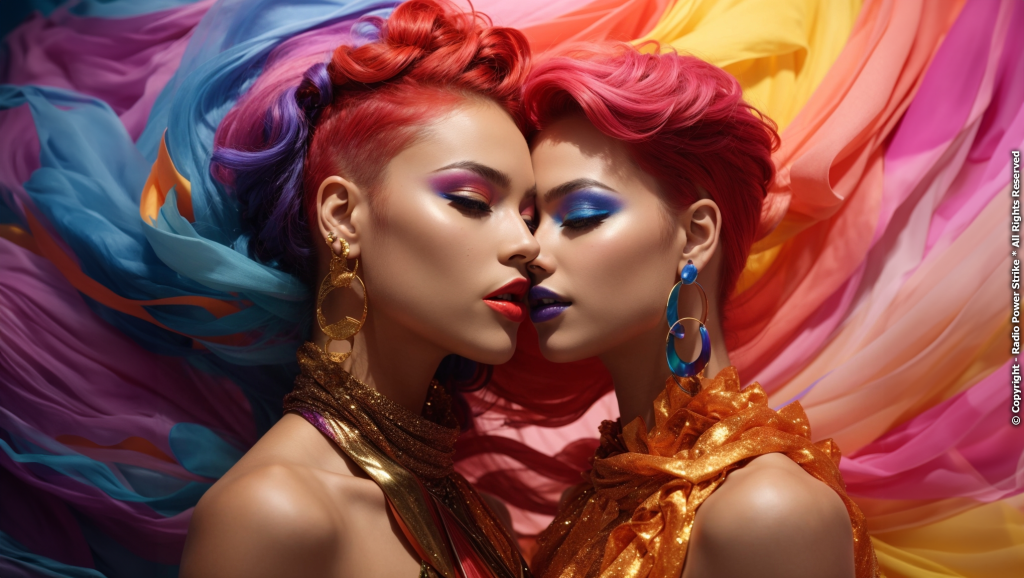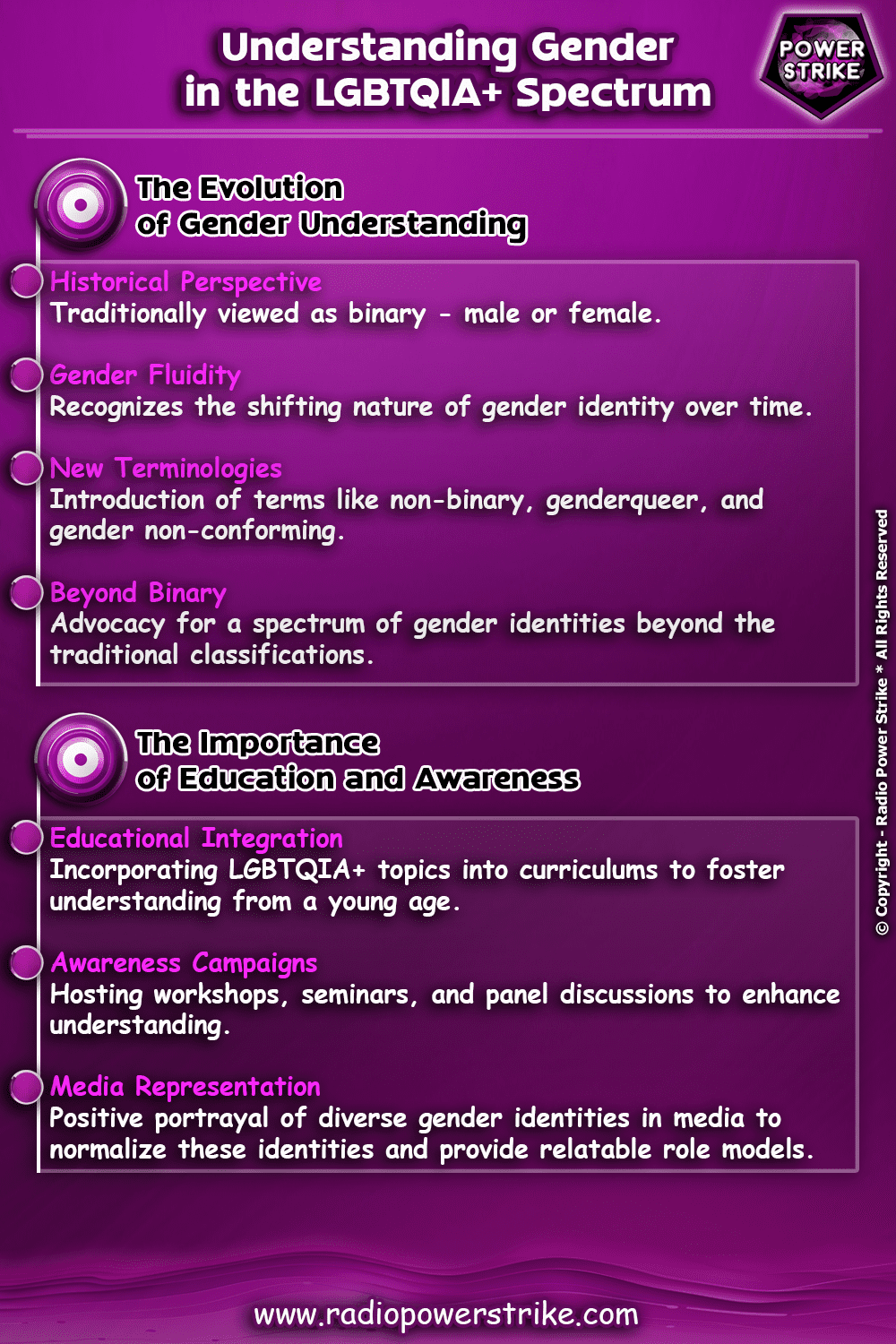Embracing Fluidity: Understanding Gender in the LGBTQIA+ Spectrum
Navigating the Nuances of Gender Identity and Expression

In today’s progressive world, understanding the vast spectrum of gender within the LGBTQIA+ community is more crucial than ever. As society moves away from rigid gender norms, it’s essential to recognize and respect the fluidity and diversity of gender identities and expressions. This article aims to shed light on the nuances of gender within the LGBTQIA+ spectrum, emphasizing the importance of education, acceptance, and open-mindedness.
The Evolution of Gender Understanding
Historically, gender has been viewed through a binary lens: male or female. However, as society progresses, we’ve come to understand that gender is far more complex and multifaceted. The LGBTQIA+ community has been instrumental in challenging and expanding these traditional notions, advocating for a more inclusive and comprehensive understanding of gender.
The concept of gender fluidity, where an individual’s gender identity or expression shifts over time, is gaining recognition. This fluidity challenges the age-old belief in fixed gender roles and emphasizes the idea that gender can be a spectrum, not just a binary choice. Recognizing this fluidity is a step towards a more inclusive society where individuals are not confined by outdated gender norms.
Moreover, the LGBTQIA+ community has introduced society to terms like non-binary, genderqueer, and gender non-conforming. These terms, among others, highlight the vast array of gender identities that exist beyond the traditional male and female classifications. By understanding and using these terms correctly, we can foster a more inclusive and respectful environment for all.
The Importance of Education and Awareness
Education plays a pivotal role in breaking down misconceptions and biases related to gender. By integrating LGBTQIA+ topics into educational curriculums, we can foster understanding and acceptance from a young age. This not only benefits LGBTQIA+ students but also creates a more inclusive environment for everyone.
Awareness campaigns, workshops, and seminars can further enhance understanding. By bringing in LGBTQIA+ speakers or hosting panel discussions, institutions can provide firsthand insights into the experiences and challenges faced by the community. Such initiatives can dispel myths, challenge stereotypes, and promote genuine understanding.
Furthermore, media representation matters. Seeing diverse gender identities portrayed positively in movies, TV shows, and literature can normalize these identities for broader audiences. Representation can also provide LGBTQIA+ individuals with relatable role models, reinforcing the idea that they are not alone in their experiences.

Challenges and the Path Forward
Despite the progress made, challenges persist. Misunderstandings, biases, and outright discrimination against non-traditional gender identities are still prevalent. Addressing these challenges requires continuous effort, advocacy, and education.
Support systems, both formal and informal, are crucial. LGBTQIA+ support groups, helplines, and counseling services can provide individuals with the resources and guidance they need. These platforms can also offer a safe space for individuals to share their experiences, seek advice, and find community.
Lastly, allyship plays a vital role. Allies, those who support and stand up for the LGBTQIA+ community, can amplify voices, challenge discriminatory practices, and advocate for change. By standing together, we can create a world where every individual feels seen, heard, and valued, irrespective of their gender identity or expression.
Understanding and embracing the fluidity of gender within the LGBTQIA+ spectrum is not just about being politically correct; it’s about recognizing the inherent worth and dignity of every individual. As society continues to evolve, it’s our collective responsibility to ensure that everyone, regardless of their gender identity or expression, feels accepted, respected, and celebrated.
Glossary
Gender Fluidity
A term used to describe a gender identity that may change or shift over time within or outside the male/female gender binary.
Non-Binary
A gender identity that does not fit within the traditional binary of male or female.
Genderqueer
A gender identity that rejects the binary categories of male and female and exists outside of these classifications.
Gender Non-Conforming
A term used to describe individuals whose gender expression does not align with societal expectations based on their perceived gender.
Allyship
The active practice of promoting the rights of LGBTQIA+ community, often undertaken by individuals who do not identify as LGBTQIA+ themselves.
LGBTQIA+ Support Groups
Organizations or communities that provide support, resources, and a safe space for LGBTQIA+ individuals.
Media Representation
The portrayal of LGBTQIA+ individuals in various media platforms, which can influence societal perceptions and attitudes towards the community.
Frequently Asked Questions
How is the concept of gender evolving in today’s society?
In recent years, society has begun to move away from rigid gender norms and embrace a more fluid and inclusive understanding of gender. This includes recognizing non-binary, genderqueer, and gender non-conforming identities as valid and important aspects of the gender spectrum.
What role does education play in fostering a more inclusive understanding of gender?
Education is pivotal in breaking down misconceptions and biases related to gender. Integrating LGBTQIA+ topics into educational curriculums can foster understanding and acceptance from a young age, creating a more inclusive environment for everyone.
Why is media representation important for the LGBTQIA+ community?
Positive media representation can normalize diverse gender identities for broader audiences, providing LGBTQIA+ individuals with relatable role models and reinforcing the idea that they are not alone in their experiences.
What challenges does the LGBTQIA+ community face in terms of gender identity and expression?
Despite progress, challenges persist, including misunderstandings, biases, and discrimination against non-traditional gender identities. Addressing these challenges requires continuous effort, advocacy, and education.
How can individuals support the LGBTQIA+ community in their fight for gender inclusivity?
Support can come in various forms, including allyship, where individuals stand up for the LGBTQIA+ community, amplifying voices, challenging discriminatory practices, and advocating for change.
What are some resources available for individuals seeking support or information about gender fluidity?
There are numerous resources available, including LGBTQIA+ support groups, helplines, and counseling services, which offer a safe space for individuals to share experiences, seek advice, and find community.
How can one be a good ally to the LGBTQIA+ community?
Being a good ally involves educating oneself about the community’s experiences and challenges, actively challenging discriminatory practices, and advocating for change to foster a more inclusive society.

Comments are closed, but trackbacks and pingbacks are open.